Please note: The analysis below is based on an initial estimate of the 2018 electorate. Catalist released an updated analysis of the 2018 electorate in May 2019.
January 28, 2019
Author: Zachary Crowell, Analyst
After narrowly winning with 50.2% of the vote in 2012, Heidi Heitkamp became one of four incumbent Democratic Senators who lost in 2018. Despite the early polling and expected competitiveness of the race, Heitkamp lost decisively with 44.3% of the vote. However, this was not as wide a margin of defeat as seen in the past two presidential elections where Trump and Romney carried the state with 67.9% and 59.8% of the votes. In examining the differences between Heitkamp’s recent loss and prior elections, there are three key trends that merit discussion:
- Widening of both the gender and marriage gaps in Democratic margin.
- Growing regional divides between eastern and western North Dakota.
- The oldest electorate since at least 2006.
Widening Gender and Marriage Gaps
The difference in vote preferences between women and men were atypically large in North Dakota in 2018. Heitkamp performed 19 percentage points better with women than men in 2018. Her vote margin was a narrow 2 percentage point loss with women, but a 21 percentage point loss among men. Additionally, the difference in vote preferences between unmarried and married voters was even more notable. Heitkamp’s difference in margin between single and married voters was 33 percentages points.
Furthermore, when comparing the Democratic margin 2018 to 2016, the gap among female and male voters grew by 5 percentage points and the gap among married voters and single voters grew by 19 percentage points.
These two preference gaps also grew as a combined group. Particularly, single women (18 percent of the 2018 electorate) voted 43 percentage points more Democratic in 2018 than in 2016. By contrast, married men voted 18 percentage points more Democratic (33 percent of the total electorate). While both figures are sizable, the difference between single women and married men grew by 24 percentage points.
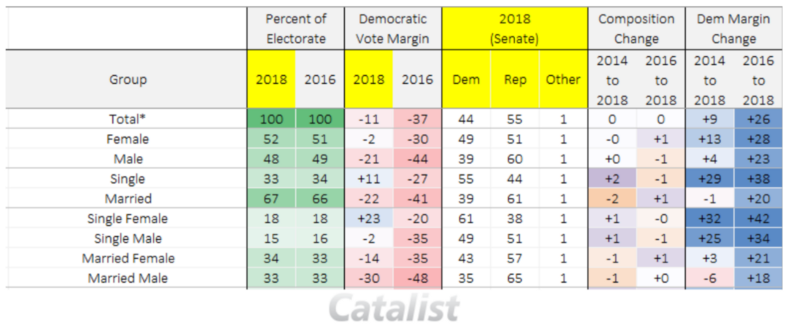
Moreover, these increases are large even compared to national trends. Recall a few figures from our post on the national Congressional results. Nationally, Democratic House candidates improved 6 percentage points with women from Hillary Clinton’s vote margin. Meanwhile, men swung 4 percentage points towards Democrats, yielding an increase in the gender gap of ~2.5 percentage points. As a combined group, House candidates improved 12 percentage points among single women and less than 1 percentage point among married men, increasing the group difference by 11 percentage points.
Importantly, these trends hold when we look at only those voters who cast ballots in both 2016 and 2018. For example, among consistent voters, Heitkamp performed 39 percentage points better with single women than Clinton, and 17 percentage points between with married men.
One potential factor consistent with the sizable increase in gender and marital status preference gaps is the unique impact the Brett Kavanaugh nomination to the Supreme Court had on the election in North Dakota. According to a Brennan Center for Justice report on television ad spending around the nomination, an estimated $1,434,720 was spent specifically in North Dakota in support of the nomination. In other words, slightly more than a quarter of all state-specific spending that went towards ad buys from conservative groups was spent in North Dakota.
This ad spending around the Supreme Court is unlikely to have fully caused these vote preference trends. However, the it points at the potential salience of the issue among 2018 North Dakota voters.
Geographic Divergence
Historically, economic conditions have large effects on election outcomes. Before the 2018 midterms, several observers wondered how soybean tariffs and recent growth in the oil, mining, and natural gas industry would alter voters’ decisions. Unlike many states, North Dakota has a sizable share of its economy devoted to both sectors:
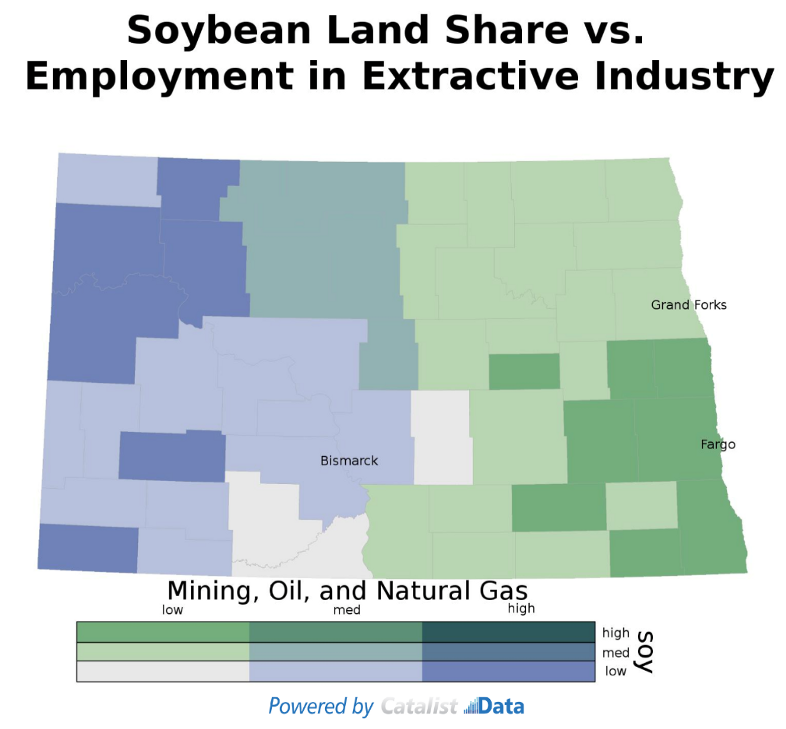
There exists considerable overlap between areas where Heitkamp overperformed both Clinton and Obama and where soybean farming is concentrated.1Specifically, the percent of land, by county, where soybeans were planted in 2017 per the USDA. Additionally areas which she Heitkamp received a lower vote share than Obama are concentrated in areas with above average employment in resource extraction.2Specifically, the percent of the workforce, by county, employed in mining, quarrying, and oil and gas from the 2016 ACS.
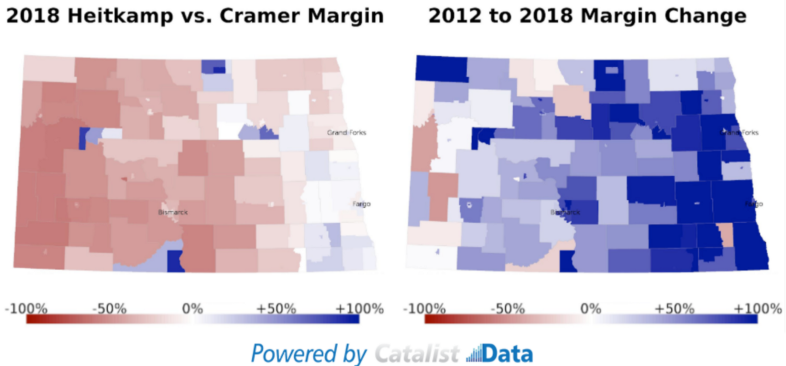
These two trends help explain the increased geographical polarization across the state, and hints at the possibility of North Dakota becoming an increasingly Republican stronghold if the resource extraction industry continues to increase its share of the state economy. Importantly, a county’s prevalence of soybean production and its share of employment in resource extraction are predictive of Heitkamp’s overperformance relative to Clinton even at controlling for other potential regional divides like population density.
An Aging Electorate
In 2018, North Dakota’s electorate was the oldest seen going back to at least 2006. The median end-of-year age in 2018 was 56. Notably the 65+ age group grew to 31% of voters in 2018 from 27% of voters in 2014. In, fact this group is the only age group that has consistently increased its share of the electorate across cycles:
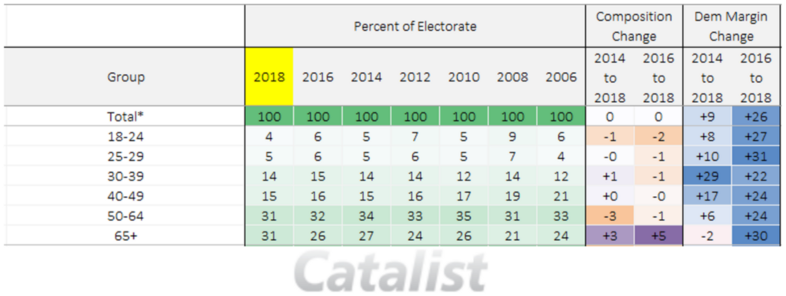
Looking at the full age distribution shows a similar pattern across years:
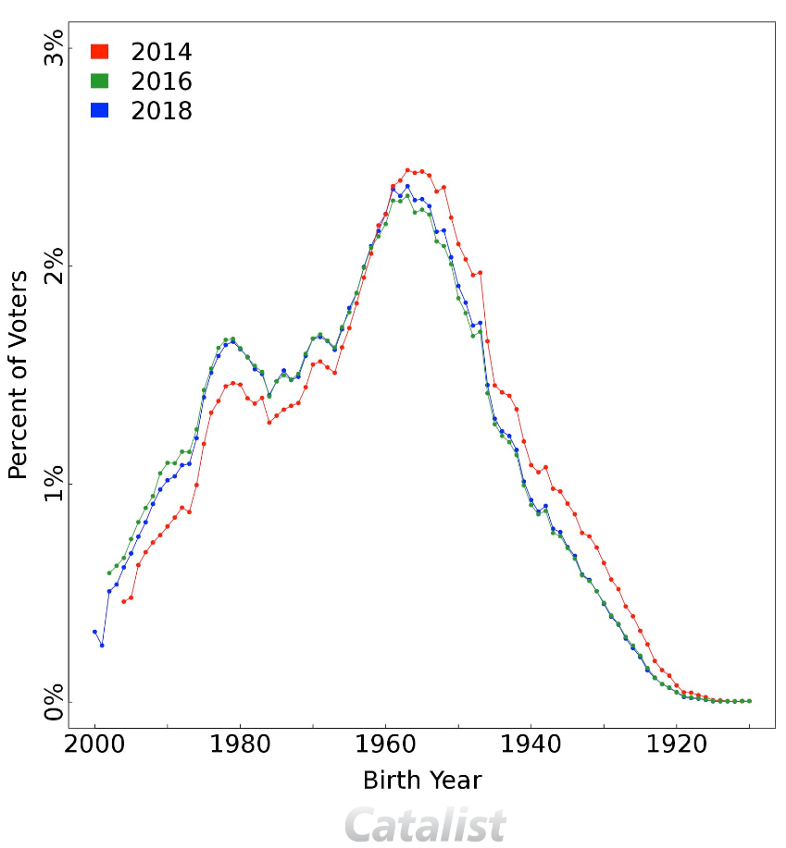
Moreover, the median voter age across presidential elections (from 50 in 2008, to 52 in 2012, and then 53 in 2016) and midterms (from 52 in 2006, to 54 in 2010, to 55 in 2014, and then 56 in 2018) has steadily increased every election cycle from a low of 50 in 2008 to the current high of 56. As age is a good predictor of party preference, one wonders if this 12 year trend will contribute to more Republican electorate in the state’s future elections.

